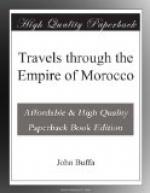After firing two or three guns by way of signal to the Vice-consul, announcing my arrival, as the Captain had directions only to put me on shore, and to proceed to sea immediately to join Lord Collingwood’s fleet, my baggage was put into a large Moorish boat, and I entered the river Boosega (commonly called St. Martin) in the Captain’s barge. This river is defended by a castle of singular construction, the entrance to which is by means of a ladder to a door in the upper story, and which ladder is occasionally drawn up. The four angles of the building are finished with small turrets, capped with clumsy domes, and having several ports for cannon. Near this place many of the Emperor’s gallies anchor, and winter.
Having proceeded a considerable way up the river, we landed at another castle, called the Custom-house. On my landing, I was received by the Vice-consul (an opulent Jew, and a native of Barbary), accompanied by the commanding officer and his troop. They conducted me to the Custom-house, which is built of stone, and whitewashed, arid, at a distance, appears to very great advantage. We entered this public building by an arched gateway, and proceeded through a winding passage into a quadrangle, in the centre of which is a well of excellent water. Near the well was an arcade, shaded by a grape-vine, to which I was conducted, and there placed in an old arm-chair. The Vice-consul and the Moorish commandant seated themselves cross-legged, upon mats spread upon the floor, and dinner, consisting of roasted fowls and fried sardinias, was immediately served.
After dinner my baggage was put upon mules, and a saddle-horse was brought for me. This animal was perfectly white, and loaded with an enormous saddle, which had a large peak before and behind, covered with a scarlet cloth, and furnished with a pair of stirrups of a curious form, much resembling a coal-scuttle; but, outre as this appeared, I assure you, I found myself very comfortably seated, and perfectly secure from falling. Thus equipped, we set forward for Tetuan, accompanied by a Moorish officer and twelve horsemen.
Whips are not in fashion in this country, and their place is supplied by two long ends of the bridle, cut to a point; but the horses, though very spirited, are perfectly under command, and need neither whip nor spur.
The town of Tetuan is seen at a great distance, from being built, like Tangiers, on the declivity of a high hill, and the houses being whitewashed. The road from the Custom-house is abominably bad; it lies across a wearisome, barren plain, surrounded by craggy mountains. Here and there, indeed, may be seen a small fertile spot, covered with cattle, sheep, and goats, and occasionally a well, encompassed by a wall of broad flat stones, capable of affording a seat to a dozen people. On approaching the city, however, the country appears more cultivated, luxuriant, and rich.




